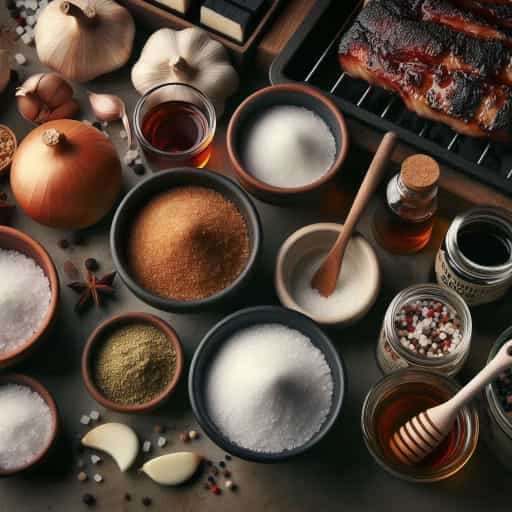Barbecue sauces have been tickling taste buds for centuries, reflecting the colorful culinary traditions from which they sprouted. These sauces pack a punch in flavor, and they come with a story as rich as their taste. From America’s Deep South to the fiery pits of Texas, each region has spiced up its own unique version.
Flavor-wise, barbecue sauces are anything but boring. With a range from super sweet to smokin’ hot, there’s something for everyone. Whether you dig a honey-glazed finish or crave an extra kick of heat, choosing your BBQ sauce means considering how it complements your dish. That’s where a little experimentation can unlock amazing flavor combinations you might never have imagined.
Regional varieties are at the heart of barbecue culture. You’ve got your Kansas City classics slathered in thick, tangy goodness, and then there’s Carolina’s mustard-style splash that’s both sweet and tangy. On the flip, you might find a spicy, vinegar-heavy punch in some parts of North Carolina. Each variation is a testament to the locale’s history and available ingredients, making every sauce a little taste of home.
While barbecue sauces are a feast for the senses, they’re not all about taste. Many contain beneficial ingredients like tomatoes and vinegar, which add a bit of nutritional value to your meals. But, it’s important to keep an eye on sugar content if you’re watching your diet. Opt for versions with natural sweeteners or those that are labeled low-sugar if health is a priority.
The Delightful Essence of Dry Rubs
Diving into the world of dry rubs might seem like opening a treasure chest of spices and flavors. These mixtures aren’t just about rubbing down a chunk of meat. They’re a blend of tradition, knowledge, and a bit of culinary flair. People have been mixing up dry concoctions for ages, often passed down through generations as secret family ingredients.
What really makes dry rubs stand out is the science of how they work. They cover the meat, creating a flavorful crust as they cook. This crust locks in moisture while letting those spices seep in, building a taste profile that’s both full-bodied and complex. It’s a balance between savory, sweet, spicy, and everything in between, dictated by what’s in the mix.
Each region puts its own spin on dry rubs, much like BBQ sauces. You’ll find some that stick to simple salt and pepper, especially in Texas. Meanwhile, regions like Memphis might include smoky paprika or brown sugar to add a little extra something to their meals. It’s a reflection of the flavors that define the local barbecue style.
Applying a dry rub is about more than just sprinkling some spices. The trick lies in knowing when and how to really get those flavors into the meat. Usually, it starts with getting a nice, even coat over every nook and cranny. Then comes the waiting game—letting the meat marinate in the rub for a few hours, or even overnight if you’ve got the time.
One of the biggest draws of using dry rubs is their health benefits. There’s typically no sugar or unnecessary fat messin’ up the mix, making them a cleaner choice for those keeping tabs on their diet. Plus, they can boost the taste without adding calories, making them a favorite among health-conscious grill masters.

Taste Test: Barbecue Sauce Vs. Dry Rubs
When it comes to flavor, the cooking method greatly influences the outcome whether you’re team sauce or team rub. Sauces often caramelize on the grill, leading to a sticky sweetness that’s hard to resist. On the other hand, dry rubs create a flavorful crust, adding a satisfying texture to your bites.
Taste preferences often divide folks into two camps: those who thrive on the saucy goodness and those who swear by that earthy, spice-filled bark from a well-applied rub. Sauce enthusiasts love how it can add layers of taste that soak into the meat, while rub enthusiasts argue the deep, penetrating flavor profile takes the lead.
Texture and juiciness are hot topics in this debate. Dry rubs are known for locking in moisture under a spicy crust, ensuring every bite of, say, a brisket, is tender and juicy. Conversely, sauces can sometimes add a wet or sticky texture that some people crave.
It’s here that experimentation becomes a thrilling adventure. Pairing meats with the right sauce or rub can elevate your barbecue. Try a vinegar-based sauce with pork, or a peppery rub on beef. Mixing and matching can lead you to discover winning combos tailored for your palate.
Conclusion: Choosing Your Flavor Frontier
Picking the right flavor partner for your barbecue isn’t about right or wrong but what suits your taste. Consider the occasion, type of meat, and cooking style when you’re in the kitchen or out on the grill. Some days call for the nuanced flair of a dry rub, while others scream for that saucy touch.
If you’re the DIY type, whipping up your sauce or rub at home can be a real gamechanger. Adjusting flavors to suit your preferences makes it personal. Plus, you control what goes in, perfect if you’re mindful of ingredients.
Using both sauces and rubs together can unlock a whole new realm of possibilities. Starting with a rub and finishing with a sauce can offer the best of both worlds—firm texture, marinated flavor, and a little zest.
Barbecue is as much about the journey as it is about the destination. It embraces diversity in tastes, and exploring different methods makes grilling exciting and delicious. Whether you’re all about sauce, committed to rubs, or somewhere in between, flavor deserves a place at your table.
**This post contains affiliate links. If you make a purchase through these links, I may earn a commission at no extra cost to you.**
If you’d like to learn more about making dry rubs check out the following link – https://amzn.to/3UEAgLd
